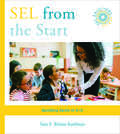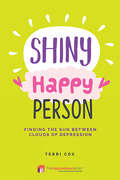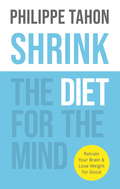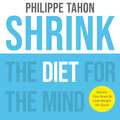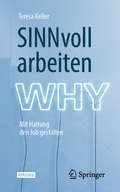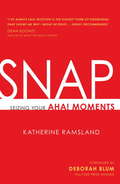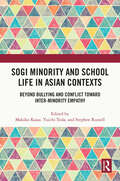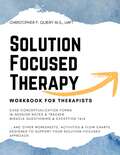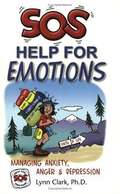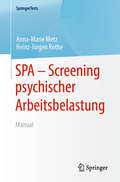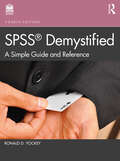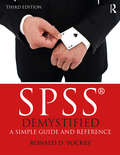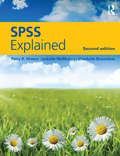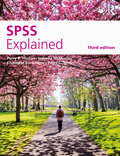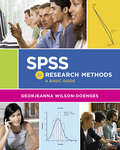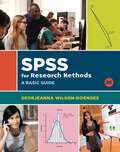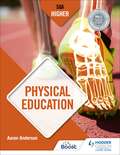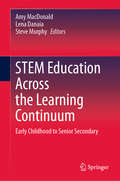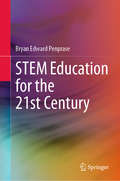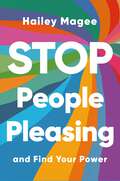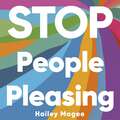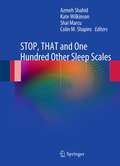- Table View
- List View
SEL from the Start: Building Skills In K-5 (Social and Emotional Learning Solutions #0)
by Sara E. Rimm-KaufmanLessons to begin using from the first day of school. Teachers are trained to manage misbehavior in the classroom, but receive little guidance about how to cultivate positive, prosocial behavior. With this book in hand, elementary teachers will be ready to launch the school year with confidence, using the concrete strategies in each chapter for improving students’ SEL skills in the five categories defined by CASEL (the Collaborative for Academic, Social, and Emotional Learning): communication skills, emotion management, emotional awareness, social awareness, and decision-making skills. This handy guide breaks down instruction of these skills into small, sequenced steps, making it easy to foster students’ skills from the start of school and build on them as the year progresses.
SHP: Finding the Sun Between Clouds of Depression (Inspirational Series)
by Terri CoxYoung, talented, intelligent, and with a thriving social life, on the surface Terri Cox had it all. But deep down in her mind a storm was brewing, and a series of life-changing events were about to unfold in quick succession that would send her spiralling into a full mental breakdown.Over the next few weeks and months, Terri was tormented by panic attacks, suicidal thoughts, bouts of insomnia, crippling headaches, severe weight loss and horrific side effects from antidepressants. Fearful of large crowds and ashamed of admitting what was happening to her, she did her best to hide away and shut herself off from society.Wracked with despair and suffering from hallucinations, Terri was taken by her family to the local A&E. When she was discharged, they desperately sought the help of a local psychotherapist. Using a highly effective and innovative form of psychotherapy, Terri was able to revisit the traumas of her past in order to understand the workings of her mind in the present. Slowly but surely, she was able to fight back and find that shiny, happy person that she'd always been before.
SHRINK: The Diet for the Mind
by Philippe TahonPhilippe Tahon has made a thrilling discovery, and it's something many of us will want to know. This highly sought-after London psychotherapist has created a unique set of tools that not only enabled him to lose five stone, but is now doing the same for hundreds of others.In Shrink, Philippe shares his easy programme and teaches you to eat mindfully, intuitively and positively. He encourages you to throw away the rulebook and free yourself forever from emotional eating and the diet trap.In being mindful we can tell how hungry we really are. Using our intuition, we eat only what our body knows is good for us, and when. By eating positively, we no longer regard food as the enemy but make friends with it, embracing it for the pleasure and nourishment it brings. Philippe's holistic technique gives you back your confidence, allows you to retake control and enjoy food guilt-free. Step by step, his clients identify the patterns in their eating habits and learn how to eat what they like whilst losing weight for good. The simple beauty of this hugely successful programme is that it allows you to 'think like a shrink' and have the body you really want - for life.
SHRINK: The Diet for the Mind
by Philippe TahonPhilippe Tahon has made a thrilling discovery, and it's something many of us will want to know. This highly sought-after London psychotherapist has created a unique set of tools that not only enabled him to lose five stone, but is now doing the same for hundreds of others.In Shrink, Philippe shares his easy programme and teaches you to eat mindfully, intuitively and positively. He encourages you to throw away the rulebook and free yourself forever from emotional eating and the diet trap.In being mindful we can tell how hungry we really are. Using our intuition, we eat only what our body knows is good for us, and when. By eating positively, we no longer regard food as the enemy but make friends with it, embracing it for the pleasure and nourishment it brings. Philippe's holistic technique gives you back your confidence, allows you to retake control and enjoy food guilt-free. Step by step, his clients identify the patterns in their eating habits and learn how to eat what they like whilst losing weight for good. The simple beauty of this hugely successful programme is that it allows you to 'think like a shrink' and have the body you really want - for life.
SHRINK: The Diet for the Mind
by Philippe TahonPhilippe Tahon has made a thrilling discovery, and it's something many of us will want to know. This highly sought-after London psychotherapist has created a unique set of tools that not only enabled him to lose five stone, but is now doing the same for hundreds of others.In Shrink, Philippe shares his easy programme and teaches you to eat mindfully, intuitively and positively, he encourages you to throw away the rulebook and free yourself forever from emotional eating and the diet trap.In being mindful we can tell how hungry we really are. Using our intuition, we eat only what our body knows is good for us, and when. By eating positively, we no longer regard food as the enemy but make friends with it, embracing it for the pleasure and nourishment it brings. Philippe's holistic technique gives you back your confidence, allows you to retake control and enjoy food guilt-free. Step by step, his impressive list of clients - including fellow therapists and celebrities - identify the patterns in their eating habits and learn how to eat what they like whilst losing weight for good. The simple beauty of this hugely successful programme is that it allows you to 'think like a shrink' and have the body you really want - for life.(p) 2018 Octopus Publishing Group
SINNvoll arbeiten: Mit Haltung den Job gestalten
by Teresa KellerWer kennt es nicht, Veränderungsdruck, Zeitknappheit und das Gefühl nur noch zu reagieren und nicht mehr zu agieren?Dieser Ratgeber zeigt auf, wie man Zeiten, in denen alles komplexer, schneller und unbeständiger wird, mit Integrität begegnen kann. So können Sie Haltung bewahren und im Wandel Stabilität generieren. Damit gelingt es Ihnen, sich und Ihr Umfeld positiv zu gestalten und nachhaltig maßgebliche Erfolge zu erzielen.Mehr noch, dieses Buch führt Sie zu einer konstruktiven Reflexion mit sich selbst. Es bietet durch fünf Grundpfeiler des integren Verhaltens eine hilfreiche Struktur zur persönlichen Weiterentwicklung. Sie gewinnen Standhaftigkeit und bleiben bei sich selbst, was Ihnen auch die Toleranz anderen gegenüber ermöglicht. Erfahren Sie, wie Sie in Veränderungsprozessen die häufig auftretenden Sinnkrisen durch Haltung, Orientierung und Integrität minimieren und in Erfolg transferieren können. Zielgruppen: Alle, die sich in bewegten Zeiten mehr Orientierung wünschenBerufstätige, die in ihrer Arbeit gerne wirksamer sein wollenFach- und Führungskräfte, Unternehmerinnen und UnternehmerVerantwortliche im Bereich Personal-, Organisations – und TeamentwicklungBerater und Coaches Zur Autorin: Dr. Teresa Keller ist seit 2008 ist sie als Beraterin, zertifizierter Coach und Buchautorin tätig und arbeitet an Themen wie Implementierung von Integritätsmanagement, Teamentwicklung, Konfliktmediation und strategische Ausrichtung. Sie ist Dozentin für die Themen Teamentwicklung und Führung in Unternehmen. 2013 gründete sie das Flourishing Institut.
SNAP
by Katherine RamslandSudden flashes of inspiration have triggered many discoveries and inventions throughout history. Are such aha! moments merely random, or is there a way to train the brain to harness these seemingly unpredictable creative insights? This fascinating overview of the latest neuroscience findings on spontaneous thought processes, or "snaps," describes how everyone--not just geniuses--can learn to improve the likelihood of their own "eureka" moments by adopting certain rewarding attitudes and habits. As the author explains, snaps are much more than new ideas. Snaps are insights plus momentum--they instantly compel or snap us toward action. They often occur after ordinary problem solving hits an impasse. We may feel stuck, but while we're in a quandary, the brain is rebooting. Then, when we least expect it, the solution pops into our heads. She describes the results of numerous scientific experiments studying this phenomenon. She also recounts intriguing stories of people in diverse disciplines who have had a snap experience. Both the research and the stories illustrate that it's possible to enhance our facility for snap moments by training ourselves to scan, sift, and solve. Scanning involves learning such habits as watching for opportunities and ideas, setting goals, coordinating short-and long-term memory, and letting the mind wander creatively. Sifting has to do with our mental maps, developing mental flexibility, balancing practice and play, and shaping information into new patterns. Finally, solutions occur when trust in our inner resources outweighs perceived risk, and we know when to stop thinking and to just relax. Throughout this insightful book, Ramsland offers puzzles and exercises to demonstrate how the aha! experience can be achieved. Readers can use the suggestions for cultivating snaps in their own lives.In the emerging economy, businesses and individuals need new strategies, and it's clear that just thinking harder no longer works. People who can snap are often a step ahead: they have a vigilance advantage from exercising brain cells that build mental agility. While snapping is rewarding, fun, and good for improving our mental skills, it's also much more: people who snap life-changing ideas that affect many others will redirect our future. Written in an accessible, jargon-free narrative that weaves together the latest research with illuminating stories of innovative people, this book teaches us how to cultivate our own inner epiphanies to gain an edge in our imaginations, our careers, our goals--indeed, in every aspect of our lives.
SOGI Minority and School Life in Asian Contexts: Beyond Bullying and Conflict Toward Inter-Minority Empathy
by Stephen Russell Yuichi Toda Makiko KasaiRepresenting an often overlooked population, this book explores the experiences of LGBTQ+ youth in Asian countries. Contributors focus on LGBTQ+ youth’s school life experiences, including bullying and violence, a pervasive and serious problem. This book aims to inform psychologists, mental health providers, and school professionals about the needs of LGBTQ+ youth from eight different Asian countries. Individual chapters present unique aspects of LGBTQ+ youth experiences in school contexts from different cultural perspectives. In addition, the intersectionality of LGBTQ+ and other minorities (including ethnicity, religion, and social class) highlights multiple sources of oppression or discrimination that can create additional pressures and stress for youth. The concepts of inter-minority conflict and inter-minority empathy are introduced to understand minority issues from new perspectives. This is a valuable reference for psychologists, social workers, counselors, nurses, mental health professionals, and students, whether preparing for general practice, treating LGBTQ+ clients, or supporting LGBTQ+ youth in schools around the world.
SOLUTION FOCUSED THERAPY: Workbook for Therapists
by Christopher F. Quiery LmftSolution Focused Therapy is a is a short-term, goal-oriented methodology of counseling designed to help clients change their lives by constructing solutions instead of simply focusing on the problems. Instead of spending a vast amount of time analyzing issues from the past, being solution-focused in approach allows the therapist and their client to work together and find positive solutions -- by asking quality questions, establishing SMART goals, celebrating the small, yet important victories, and identifying desired outcomes instead of simply dwelling on the past. Clients are able to discover their inner hero -- someone armed with powerful resources and many personal strengths. This workbook will discuss some of the core components to the methodology while offering an array of unique worksheets & activities aimed to support this counseling approach. Worksheets and activities found in this workbook will include: Tools for creating actionable goals while defining desired outcomes The 'Miracle Question' and ways to work through roadblocks Uncovering one's heroic journey and the strengths this journey will uncover Case Conceptualization forms for Session #1 and follow-up sessions The 'Solutions Matrix' ... and much more!! Ultimately, these worksheets can support a therapist in opening up more dialogue with their client.
SOS for Emotions: Managing Anxiety, Anger, and Depression (Second Edition)
by Lynn ClarkSOS is intended for both adults and older teens who desire to achieve increased self-knowledge and greater control over their unpleasant emotions and teaches principles and self-help methods from the cognitive behaviour therapy perspective.
SPA - Screening psychischer Arbeitsbelastung: Manual (SpringerTests)
by Anna-Marie Metz Heinz-Jürgen RotheArbeitsbedingte psychische Erkrankungen sind in den letzten 10 Jahren zu den häufigsten Ursachen für Fehlzeiten und Erwerbsminderungsrenten geworden. Im Mittelpunkt des Buches stehen die detaillierte Beschreibung eines psychologischen Verfahrens zur qualitätsgesicherten, effizienten und praktikablen Analyse und Beurteilung psychischer Belastungsfaktoren in Arbeitsprozessen. Aus den Ergebnissen werden Hinweise für bedingungs- und personenbezogene gesundheitsförderliche Maßnahmen abgeleitet. Das Instrument hat sich bei Gefährdungsbeurteilungen in Unternehmen aller Größen und Branchen bewährt, es ermöglicht, Schwachstellen in der Gestaltung von Arbeitssituationen zu identifizieren sowie komplexe Beziehungen zwischen Arbeitsinhalt, Arbeitsbedingungen und deren Folgen wissenschaftlich aufzuklären.
SPSS Demystified: A Simple Guide and Reference
by Ronald D. YockeyWithout question, statistics is one of the most challenging courses for students in the social and behavioral sciences. Enrolling in their first statistics course, students are often apprehensive or extremely anxious toward the subject matter. And while IBM SPSS® is one of the more easy-to-use statistical software programs available, for anxious students who realize they not only have to learn statistics but also new software, the task can seem insurmountable. Keenly aware of students’ anxiety with statistics (and the fact that this anxiety can affect performance), Ronald D. Yockey has written SPSS® Demystified: A Simple Guide and Reference, now in its fourth edition. Through a comprehensive, step-by-step approach, this text is consistently and specifically designed to both alleviate anxiety toward the subject matter and build a successful experience analyzing data in SPSS®. Topics covered in the text are appropriate for most introductory and intermediate statistics and research methods courses. Key features of the text: • Step-by-step instruction and screenshots • Designed to be hands-on with the user performing the analyses alongside the text on their computer as they read through each chapter • Call-out boxes provided, highlighting important information as appropriate • SPSS® output explained, with written results provided using the popular, widely recognized APA format • End-of-chapter exercises included, allowing for additional practice • SPSS® data sets available on the publisher’s website New to the Fourth Edition: • Fully updated to SPSS® 28 • Updated screenshots in full color to reflect changes in the SPSS® software system (version 28) • Exercises updated with up-to-date examples • Exact p-values provided (consistent with APA recommendations)
SPSS Demystified: A Simple Guide and Reference (Third Edition)
by Ronald D. Yockey<p>Without question, statistics is one of the most challenging courses for students in the social and behavioral sciences. Enrolling in their first statistics course, students are often apprehensive or extremely anxious toward the subject matter. And while SPSS is one of the more easy-to-use statistical software programs available, for anxious students who realize they not only have to learn statistics but also new software, the task can seem insurmountable. Keenly aware of students’ anxiety with statistics (and the fact that this anxiety can affect performance), Ronald D. Yockey has written SPSS Demystified: A Simple Guide and Reference, now in its third edition. Through a comprehensive, step-by-step approach, this text is consistently and specifically designed to both alleviate anxiety toward the subject matter and build a successful experience analyzing data in SPSS. <p>Key features of the text: <p> <li>Step-by-step instruction and screenshots <li>Designed to be hands-on with the user performing the analyses alongside on their computer as they read through each chapter <li>Call-out boxes provided, highlighting important information as appropriate <li>SPSS output explained, with written results provided using the popular, widely recognized APA format <li>End-of-chapter exercises included, allowing for additional practice</li> <p> <p>Features and updates to this edition include: material updated to IBM SPSS 24 (available Fall 2016), including screenshots and data sets/end-of-chapter exercises.</p>
SPSS Explained
by Perry R. Hinton Isabella McMurray Charlotte BrownlowSPSS Explained provides the student with all that they need to undertake statistical analysis using SPSS. It combines a step-by-step approach to each procedure with easy to follow screenshots at each stage of the process. A number of other helpful features are provided: regular advice boxes with tips specific to each test explanations divided into ‘essential’ and ‘advanced’ sections to suit readers at different levels frequently asked questions at the end of each chapter. The first edition of this popular book has been fully updated for IBM SPSS version 21 and also includes: chapters that explain bootstrapping and how this is used an introduction to binary logistic regression coverage of new features such as Chart Builder. Presented in full colour and with a fresh, reader-friendly layout, this fully updated new edition also comes with a companion website featuring an array of supplementary resources for students. The authors have many years of experience in teaching SPSS to students from a wide range of disciplines. Their understanding of SPSS users’ concerns, as well as a knowledge of the type of questions students ask, form the foundation of this book. Minimal prior knowledge is assumed, so the book is well designed for the novice user, but it will also be a useful reference source for those developing their own expertise in SPSS. It is suitable for all students who need to do statistical analysis using SPSS in various departments including Psychology, Social Science, Business Studies, Nursing, Education, Health and Sport Science, Communication and Media, Geography, and Biology.
SPSS Explained
by Perry R. Hinton Isabella McMurray Charlotte Brownlow Peter C. TerrySPSS Explained provides the student with all that they need to undertake statistical analysis using SPSS. It combines a step-by-step approach to each procedure with easy-to-follow screenshots at each stage of the process. A number of other helpful features are provided, including: regular advice boxes with tips specific to each test explanations divided into ‘essential’ and ‘advanced’ sections to suit readers at different levels frequently asked questions at the end of each chapter The third edition of this popular book has been fully updated for IBM SPSS version 27 and also includes: a new chapter on how to undertake mediation and moderation with SPSS updates on changes to SPSS, including updated functionality within ANOVAs and calculations of a priori power analysis Presented in full colour and with a fresh, reader-friendly layout, this fully updated new edition also comes with online support material featuring an array of supplementary resources for students and instructors. Minimal prior knowledge is assumed, so the book is well designed for the novice user, but it will also be a useful reference source for those developing their own expertise in SPSS. It is suitable for all students who need to do statistical analysis using SPSS in various disciplines, including psychology, social science, business studies, nursing, education, health and sport science, communication and media, geography, and biology. The authors have many years of experience in teaching SPSS to students from a wide range of disciplines. Their understanding of SPSS users’ concerns, as well as a knowledge of the type of questions students ask, form the foundation of this book.
SPSS for Research Methods: A Basic Guide
by Georjeanna Wilson-DoengesA new guide showing the best ways for students to analyze data and interpret results in SPSS. Georjeanna Wilson-Doenges’s direct writing style, real sample data from her research methods class, integrated APA-style results, and detailed yet clear screenshots ensure students will be confident and enthusiastic about using SPSS.
SPSS for Research Methods: A Basic Guide (Second Edition)
by Georjeanna Wilson-DoengesHelp students interpret data and analyze results in SPSS. This guide reveals the best ways for students to analyze data and interpret results in SPSS. Georjeanna Wilson-Doenges’s direct writing style, real sample data from her research methods class, integrated APA-style results, and detailed yet clear screenshots ensure that students feel confident using the program. Her exciting revision not only reflects the latest updates to SPSS and APA guidelines, but also includes new engaging step-by-step video tutorials.
SQA Higher Physical Education
by Aaron AndersonExam board: SQALevel: HigherSubject: Physical EducationFirst teaching: September 2018First exams: Summer 2019Perform to the very best of your ability in Higher PE as you master the theory and overcome the challenges of the exam.This highly visual textbook contains dozens of diagrams that make it easier to understand and remember the content.> Be guided through each area of the course. All the mandatory knowledge, skills and specification points are structured into a logical sequence for students and teachers> Get to grips with the command words. Find out what each of the five command words is asking you to do and then use the strategies provided to answer questions across each area of the course> Learn through practice. Enjoy an active approach to theory, applying and developing your knowledge through lots of dynamic and varied tasks, rather than lots of reading> Feel confident about the exam. Tips throughout the book explain how to answer questions effectively. End-of-chapter exam-style questions and two practice papers help you to revise and prepare for the exam> Check your understanding. Over 30 pages of detailed answers for all tasks, exam-style questions and practice papers are included at the back of the book, to support independent learningThe book concludes with a special chapter for teachers, which provides ideas for fun, interactive teaching strategies that are based on the latest pedagogical research into retrieval practice, cooperative learning and active learning.
SQA Higher Physical Education
by Aaron AndersonExam board: SQALevel: HigherSubject: Physical EducationFirst teaching: September 2018First exams: Summer 2019Perform to the very best of your ability in Higher PE as you master the theory and overcome the challenges of the exam.This highly visual textbook contains dozens of diagrams that make it easier to understand and remember the content.> Be guided through each area of the course. All the mandatory knowledge, skills and specification points are structured into a logical sequence for students and teachers> Get to grips with the command words. Find out what each of the five command words is asking you to do and then use the strategies provided to answer questions across each area of the course> Learn through practice. Enjoy an active approach to theory, applying and developing your knowledge through lots of dynamic and varied tasks, rather than lots of reading> Feel confident about the exam. Tips throughout the book explain how to answer questions effectively. End-of-chapter exam-style questions and two practice papers help you to revise and prepare for the exam> Check your understanding. Over 30 pages of detailed answers for all tasks, exam-style questions and practice papers are included at the back of the book, to support independent learningThe book concludes with a special chapter for teachers, which provides ideas for fun, interactive teaching strategies that are based on the latest pedagogical research into retrieval practice, cooperative learning and active learning.
START Parenting: A Guide to Thoughtful Parenting
by Doug Maclean Sue Gould MswParents/Carers- What are You Doing? What are your Kids Doing ? Bringing up Kids is a Tough Call. S.T.A.R.T. is a new, unique strategy to help put you back in the driver’s seat. The S.T.A.R.T. Strategy is based on sound theory, knowledge and practical experience from two highly skilled psychologists/social workers/counsellors/educators. Their approach is down-to-earth, realistic, compassionate and tough minded. Pick up the S.T.A.R.T Strategy- it is worth giving it a go!
STEM Education Across the Learning Continuum: Early Childhood to Senior Secondary
by Steve Murphy Amy MacDonald Lena DanaiaThis is the first comprehensive book to consider STEM education from early childhood through to senior secondary education. It approaches STEM as a form of real-world, problem-based education that draws on the knowledge and skills of the science, technology, engineering and mathematics disciplines. Rather than presenting each of the separate disciplines to an equal extent, it focuses on STEM researchers’ perspectives on how their work contributes to effective STEM education in terms of building knowledge, skills and engagement. Gathering contributions by authors from various countries, the book explores effective STEM education from a range of perspectives within the international context. Moreover, it addresses critical issues in STEM education, including transition and trajectories, gender, rurality, socioeconomic status and cultural diversity. By doing so, it not only shares the current state of knowledge in this field, but also offers a source of inspiration for future research.
STEM Education for the 21st Century (Springerbriefs In Education Ser.)
by Bryan Edward PenpraseThis book chronicles the revolution in STEM teaching and learning that has arisen from a convergence of educational research, emerging technologies, and innovative ways of structuring both the physical space and classroom activities in STEM higher education. Beginning with a historical overview of US higher education and an overview of diversity in STEM in the US, the book sets a context in which our present-day innovation in science and technology urgently needs to provide more diversity and inclusion within STEM fields. Research-validated pedagogies using active learning and new types of research-based curriculum is transforming how physics, biology and other fields are taught in leading universities, and the book gives profiles of leading innovators in science education and examples of exciting new research-based courses taking root in US institutions. The book includes interviews with leading scientists and educators, case studies of new courses and new institutions, and descriptions of site visits where new trends in 21st STEM education are being developed. The book also takes the reader into innovative learning environments in engineering where students are empowered by emerging technologies to develop new creative capacity in their STEM education, through new centers for design thinking and liberal arts-based engineering. Equally innovative are new conceptual frameworks for course design and learning, and the book explores the concepts of Scientific Teaching, Backward Course Design, Threshold Concepts and Learning Taxonomies in a systematic way with examples from diverse scientific fields. Finally, the book takes the reader inside the leading centers for online education, including Udacity, Coursera and EdX, interviews the leaders and founders of MOOC technology, and gives a sense of how online education is evolving and what this means for STEM education. This book provides a broad and deep exploration into the historical context of science education and into some of the cutting-edge innovations that are reshaping how leading universities teach science and engineering. The emergence of exponentially advancing technologies such as synthetic biology, artificial intelligence and materials sciences has been described as the Fourth Industrial Revolution, and the book explores how these technologies will shape our future will bring a transformation of STEM curriculum that can help students solve many the most urgent problems facing our world and society.
STOP PEOPLE PLEASING And Find Your Power
by Hailey Paige MageeDo you find it hard to say "no" to people? Do you tend to put others first? Do you feel guilty setting boundaries? If the answer to any of these questions is "yes", you may be a people pleaser.People-pleasing is a widespread but misunderstood response to trauma. It can have a huge impact on your mental health, showing up in common psychological conditions including anxiety, co-dependence, and depression. Left unchallenged, people-pleasing habits can lead to chronic discomfort, exhaustion, and resentment.In Stop People Pleasing, certified life coach Hailey Magee offers an action-based approach to breaking the people-pleasing pattern. Drawing on social science, psychological research, and coaching exercises, Magee gives you the practical tools you need to:- Understand the origins of your people-pleasing- Discover your own needs- Set empowered boundaries- Courageously advocate for yourselfWith fresh insight, heartfelt empathy, and a keen personal understanding of the pitfalls of people-pleasing, Magee will help you to break free from the cycle, overcome your guilt, and reconnect with your own feelings, needs, and aspirations.
STOP PEOPLE PLEASING And Find Your Power: Stop people-pleasing, get what you need and stand in your power
by Hailey Paige MageeDo you find it hard to say "no" to people? Do you tend to put others first? Do you feel guilty setting boundaries? If the answer to any of these questions is "yes", you may be a people pleaser.People-pleasing is a widespread but misunderstood response to trauma. It can have a huge impact on your mental health, showing up in common psychological conditions including anxiety, co-dependence, and depression. Left unchallenged, people-pleasing habits can lead to chronic discomfort, exhaustion, and resentment.In Stop People Pleasing, certified life coach Hailey Magee offers an action-based approach to breaking the people-pleasing pattern. Drawing on social science, psychological research, and coaching exercises, Magee gives you the practical tools you need to:- Understand the origins of your people-pleasing- Discover your own needs- Set empowered boundaries- Courageously advocate for yourselfWith fresh insight, heartfelt empathy, and a keen personal understanding of the pitfalls of people-pleasing, Magee will help you to break free from the cycle, overcome your guilt, and reconnect with your own feelings, needs, and aspirations.
STOP, THAT and One Hundred Other Sleep Scales
by Shai Marcu Azmeh Shahid Kate Wilkinson Colin M ShapiroThere are at least four reasons why a sleep clinician should be familiar with rating scales that evaluate different facets of sleep. First, the use of scales facilitates a quick and accurate assessment of a complex clinical problem. In three or four minutes (the time to review ten standard scales), a clinician can come to a broad understanding of the patient in question. For example, a selection of scales might indicate that an individual is sleepy but not fatigued; lacking alertness with no insomnia; presenting with no symptoms of narcolepsy or restless legs but showing clear features of apnea; exhibiting depression and a history of significant alcohol problems. This information can be used to direct the consultation to those issues perceived as most relevant, and can even provide a springboard for explaining the benefits of certain treatment approaches or the potential corollaries of allowing the status quo to continue. Second, rating scales can provide a clinician with an enhanced vocabulary or language, improving his or her understanding of each patient. In the case of the sleep specialist, a scale can help him to distinguish fatigue from sleepiness in a patient, or elucidate the differences between sleepiness and alertness (which is not merely the inverse of the former). Sleep scales are developed by researchers and clinicians who have spent years in their field, carefully honing their preferred methods for assessing certain brain states or characteristic features of a condition. Thus, scales provide clinicians with a repertoire of questions, allowing them to draw upon the extensive experience of their colleagues when attempting to tease apart nuanced problems. Third, some scales are helpful for tracking a patient's progress. A particular patient may not remember how alert he felt on a series of different stimulant medications. Scale assessments administered periodically over the course of treatment provide an objective record of the intervention, allowing the clinician to examine and possibly reassess her approach to the patient. Finally, for individuals conducting a double-blind crossover trial or a straightforward clinical practice audit, those who are interested in research will find that their own clinics become a source of great discovery. Scales provide standardized measures that allow colleagues across cities and countries to coordinate their practices. They enable the replication of previous studies and facilitate the organization and dissemination of new research in a way that is accessible and rapid. As the emphasis placed on evidence-based care grows, a clinician's ability to assess his or her own practice and its relation to the wider medical community becomes invaluable. Scales make this kind of standardization possible, just as they enable the research efforts that help to formulate those standards. The majority of Rating Scales in Sleep and Sleep Disorders: 100 Scales for Clinical Practice is devoted to briefly discussing individual scales. When possible, an example of the scale is provided so that readers may gain a sense of the instrument's content. Groundbreaking and the first of its kind to conceptualize and organize the essential scales used in sleep medicine, Rating Scales in Sleep and Sleep Disorders: 100 Scales for Clinical Practice is an invaluable resource for all clinicians and researchers interested in sleep disorders.
